#zanclean flood
Explore tagged Tumblr posts
Text

Yesterday, an earthquake shook the narrow coastal lands between the Atlantic Ocean to the west and the great dry abyss to the east. A landslide allowed the water to break through the narrow strip of high land and begin flooding in. The incredible power of the ocean violently widened the gap and eroded the lowlands beyond, creating an ever growing chasm and the biggest waterfall on the planet by the next day.
With the very ground under their feet unsure and brittle and the sea rushing in ever faster, some of the local animals have fled to the top of a large nearby rock outcropping that will one day be named Gibraltar. The only ones who don't seem disturbed are the Pelagornis and other sea birds, who have discovered some aerial acrobatics let them catch the fish being swept up in the flood. Though even for a bird the size of Pelagornis, an unfortunate humpback whale is way too big of a catch.
The vast, dry salt plains beyond continue much further than any of the watching animals can imagine, yet a thousand Amazons worth of water will fill up the abyss within a year or two. In the process, the Mediterranean Sea, which had dried up completely a million years before, will be reborn.
#neogene#pliocene#zanclean flood#pelagornis#gerbil#mouse#wall lizard#macaque#humpback whale#Odontopterygiform#bird#rodent#primate#mammal#flood#gibraltar#my art#paleoart#palaeoblr#miocene#messinian salinity crisis#according to some definitions this would be the second day of the pliocene#i have not been to gibraltar myself so i had to rely on google earth for references of the view of the other side#cw: animal death
95 notes
·
View notes
Text

Tonight’s flocking-together paleostream sketches, Shark week themed.
Top-left is a Thrinacoselache nibbling on a time-traveler’s lost Blåhaj plushie, top-right is a trio of Aquilolamna escorting a Terminonaris, bottom-left is a far-off Otodus megalodon being sucked into the gigantic Zanclean flood, and bottom-right is a Squalicorax, gorged with food, being followed by a young Tylosaurus.
131 notes
·
View notes
Note
18, 19, 22
18. What’s one historical event that you would have liked to have witnessed?
If prehistoric is allowed, the Zanclean Flood.
19. What’s your favorite Halloween costume from when you were a kid?
So I very much enjoyed tricker treating but the only costuming detail from my childhood that's actually stuck is my first experience with cheap black hair dye.
22. Iced or hot drinks?
Hot for another week or two, then iced as soon as the average temperature is solidly above freezing.
8 notes
·
View notes
Note
Hey! I've never heard of the Messinian Salinity Crisis. What does it entail~?
Messinian Salinity Crisis my beloved <3
Around 6 million years ago the straight of Gibraltar closed, isolating the Mediterranean sea from the Atlantic Ocean, thus stopping seawater input. Due to the hot climate, poor freshwater intakes and high evaporation rates, the Mediterranean almost (or completely, we're still debating about this) dried up. In the early stages of the crisis salinity kept rose, reflecting on the reefs that once grew in the basin. Before it was too high for corals to survive, reefs were comprised of very few species mostly Porites, Tarbellastraea and Siderastraea. Sea-level dropped more than 3000m and the extremely high salinity made its water inhabitable except for extremophiles organisms.

Now you have to imagine a very different Mediterranean, here a reconstruction of it right before the Salinity crisis in late Messinian (Vescogni 2022). During the 1million years the Mediterranean was sealed away, gypsum precipitation built impressive formations that can be around (and more than) 100m thick. Halite precipitated too, but it's more common in the Central and Western Mediterranean (Very famous are the deposits in Sicily for example).
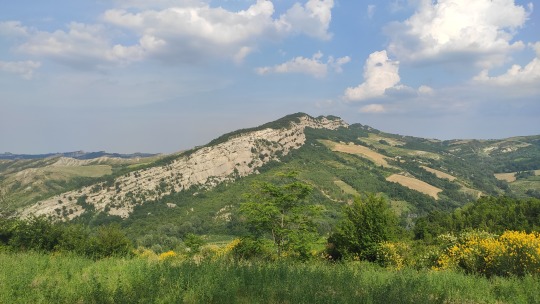
Here outcrops of Gypsum from the "Vena del Gesso" in Italy (My picture. They're impressive up close). You can see the stratification highlighted by vegetation. It is due to precession cycles. It all ended with the Zanclean flood, ~5million years ago, when Gibraltar finally reopened and the basin was filled with ocean water again.
I kept it short but books could be filled with all the many theories on the event. The gypsum precipitation on itself is worth pages and pages asdfgjskg
I have some very cool articles tho! I'd gladly share them if you're interested!
2 notes
·
View notes
Text
Submitted Via Google Form:
Building a world that used to have lots of land but over time the land sunk into the ocean so species became more aquatic and land species that could not, became endangered/died out. But how long does it take land to sink into the ocean vs how long does it take for biology to adapt? 'Perfect' adaptions if land sinks very slowly? What if land sank too quickly for good adaption? What would be the timeline for this? How about man made (I'm saying 'man' but does not need to be human beings - I'm not sure what kind of species I'm putting on this planet - just building the world then I'll decide what I can put there.) issues that slow down or quicken up the land sinking issue? What about other parts of the climate that would accompany this change?
Addy: A few thoughts.
Rising water levels - climate change can cause water levels to rise, earthquakes can cause minor sinking along a coastline (look up ghost forests, they're wild), and sometimes tectonic plates just get kinda weird. Conventional geology states that continental plates never sink, as they're less dense than oceanic plates, but a research project at the Univeristy of Chicago proposes that maybe that isn't always the case. Case of Earth’s missing continental crust solved: It sank | University of Chicago News
Zealandia is also a very interesting case - basically, the continent got stretched out, eventually getting thin enough that the ocean covered most of it. The BBC has a good article about this that's pretty free of jargon. The missing continent that took 375 years to find - BBC Future
You can also have major floods, ala the Mediterranean (in the Zanclean flood) or the Black Sea (in the Black Sea deluge), but I'm not sure if that's what you're looking for. Those types of events tend to be very, very fast, which can mean that there isn't exactly a lot of time for adaptation.
Beyond just sea levels, you can also have habitat change that make the previous aboveground areas inhospitable. That could make the ocean a better alternative for your species, even if there's still a moderate-to-large amount of land.
If the land sinks too quickly for good adaptation, you get a local/regional extinction that kills off a good chunk of creatures. The remaining critters then have an uncompetitive environment to quickly proliferate through, where they can try all sorts of wacky adaptations before the best/most efficient ones win out. We see similar patterns in the Cambrian explosion and in dinosaurs after various major extinction events.
Other parts of the climate that would change as well? Short answer, a lot. The oceans play a major role in the thermoregulation of our planet, aka the global distribution of heat. I'd recommend looking into the global ocean conveyor belt - NOAA has some excellent pages on that. The Global Conveyor Belt - Currents: NOAA's National Ocean Service Education
If sinking land means that continental shelves are somehow moving or falling apart, you might see some weird stuff happen with your oceanic conveyer belt. You don't have to address this in your culture or world, but IRL it affects the global distribution of nutrients, salt/salinity, and temperature in the oceans. In turn, those oceanic temperatures affect air temperatures and wind currents, which then affect weather patterns. An El Niño year (one with weather patterns opposite from the norm, like rain when it's normally dry) is caused by a change in water temperatures in the Pacific Ocean near the Galapagos Islands. That particular spot is on a major area for wind currents, so it's able to affect quite a lot. El Niño and La Niña | National Oceanic and Atmospheric Administration
These climate changes may or may not matter to your world's people, but oceanic changes have had far-reaching effects on Earth.
It's actually thought that modern pinnipeds - seals, sea lions, and walruses - adapted to the ocean because of a change in the oceanic conveyer belt. Put simply, in the Ogliocene (~36 million years ago), changing global temperature moved the conveyer belt in a way that brought up more nutrients from the deep ocean. The increase in nutrients allowed for more oceanic life, so there were more things to eat.
It took roughly 19 million years for the ancient Puijila species (no flippers, looked like an otter) to evolve to the Enaliarctos genus (four flippers), and then another 17 million years to our modern day.
14 notes
·
View notes
Text
365 Days of Alla Antica, Day #2
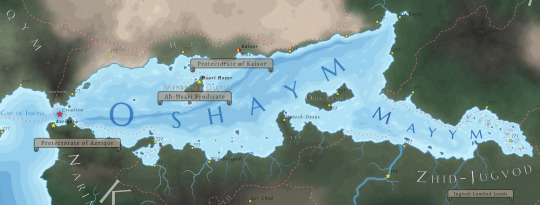
(Note, the above map is still largely a Work in Progress!)

“The Oshaym is a curiosity for those who dwell on its myriad coastlines — that is, a curiosity much like the Sun, the Eye of Aryohl, or any other casual phenomenon. It is at once a place of bounty, bringing up from its depths fish and whale oil, as well as lost treasures from ancient empires, whilst also being a vast sea of stinging salt that harbours countless dangers in the forms of the Uhdinnim and the dreaded Zroh. The Oshaym at once provides and imperils, protects and undermines, defines and defies.”

The Oshaym — meaning "Bone Sea" in the primary trade language, Dabru, spoken across the Nepshe Confederacy — is a vast sea connecting to the outside ocean only via a small channel running through the Gap of Inkyss at its western-most edge. It is named the Bone Sea for the spectral salt-encrusted white towers that occasionally thrust up from its depths, and can be seen in its shallower reaches, the last evidence of a once enormous ancient empire that spanned the salt flats of the Oshaym before it was flooded. Since the explosion of Hror Inkyss millenia ago, those same salt flats have played host to the high-salinity sea, allowing new nations to form along its banks.
The Oshaym is largely under the control of the Protectorate of Kaisor, the chief state of the Nepshe Confederacy, though their rivals in the Protectorate of Azriqor control some of the south-west coast, whilst the Zholik Timocracy and the scattered tribes of the Jugvod-Lumbad control portions of the eastern stretch known as the Mayym. The only free archipelago within the Oshaym, outside of these larger polities, is the Aħ-Ħsari Syndicate, who hold out from their home of Meħbe-set Dujru.

The Oshaym is, quite clearly, the Pyrric take on the Mediterranean Sea, with lots of inspiration drawn from its folkloric elements, especially those taken from my own culture of Ammi Maltese. Tales of Atlantis inspire the Uhdinnim Empire, the Zanclean flood inspired its downfall, and the scattering of the Late Bronze Age Collapse inspired the different peoples around the rim. The entirety of Alla Antica began because I wanted to imagine what the real world would be like if Carthage won the Punic Wars, rather than Rome, and whilst it has gone VERY far from that original inspiration, the first foundations of that were laid in the Oshaym which still exist in the setting today...
5 notes
·
View notes
Text
He opens my Strait of Gibraltar till I Zanclean flood
3 notes
·
View notes
Text
I'd recommend Stephen Baxter's novel Stone Spring, which begins an alternative history cycle where the people of Northland (Doggerland) build dams to keep the floodwaters out, so that European history runs differently.
@cansomebodytellmewhatsgoingon please tell me about the Zanclean Flood.
Do you ever think about Doggerland?
Like how fucked up is it that it’s just….. gone.

I tend to forget about it and then when I remember it again I’m like “Oh yeah! There’s like an entire country sized stretch of land that’s just fucking GONE.
well…. “gone”….

60K notes
·
View notes
Text
#aFactADay2024
#1215: the Messinian salinity crisis was the period of time, about 5.96-5.33 million years ago, that the Mediterranean Sea was mostly dried up (and very very salty). the straight of Gibraltar closed up and the basin went into a period of oscillating desiccation (i only just realised that desiccated coconut is just dried, not necessarily to do with the chopping). it was followed by the Zanclean flood, where it basically filled back up again over the span of a few months to two years - an estimated rise of 10m/day. even today, the Med is particularly salty (oh and the Black Sea even moreso ofc). if it got cut off from the Atlantic now, it would mostly evaporate within a thousand years, and subsequently get obliterated by North Africa.
0 notes
Text
My art in 2023
January
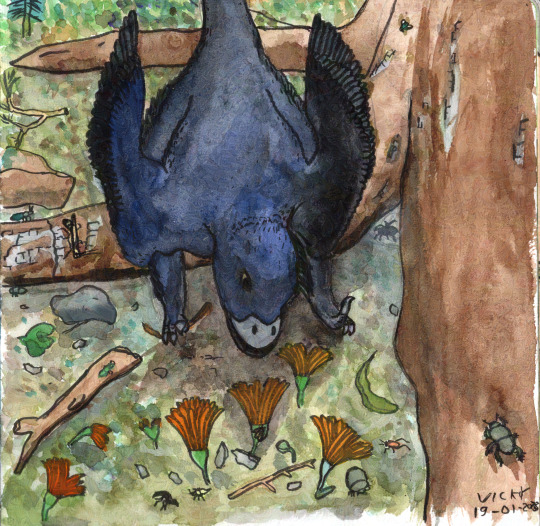
Microraptor and the Flowers. I started this year out making paleoart watercolours and never really stopped. This one is about a Microraptor investigating the first flowers she's ever seen. The flowers are Lingyuananthus, a lovely little fossil flower described in an even lovelier paper that was not behind a paywall for once.
February

Orthocones Descend. Having moved into a new apartment and made a timeline covering the walls, the paleozoic looked awfully empty, so I made a big effort to expand my horizons and do art showing creatures I'd never drawn before. Showing orthocones descending vertically on their prey made for a fun composition too.
March

Sinosauropteryx does not want to share its tree. I still can barely believe we know the colours of both Sinosauropteryx and Psittacosaurus. Dinosaur colours always felt like something we'd never figure out without literal actual time travel before we figured them out.
April
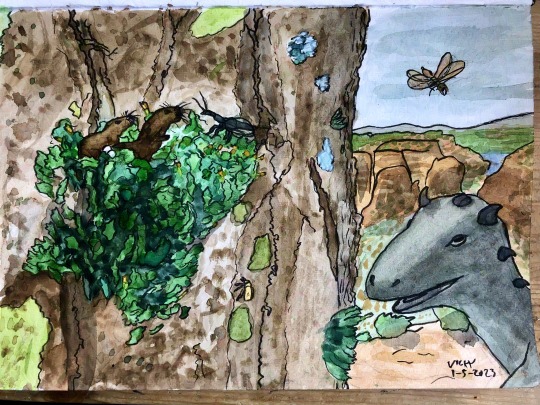
Hadrocodium's mossy home. I got the idea for one of the tiniest mammals of all time making its home in some moss on a tree while hiking in Switzerland and coming across some truly impressive moss beards.
May
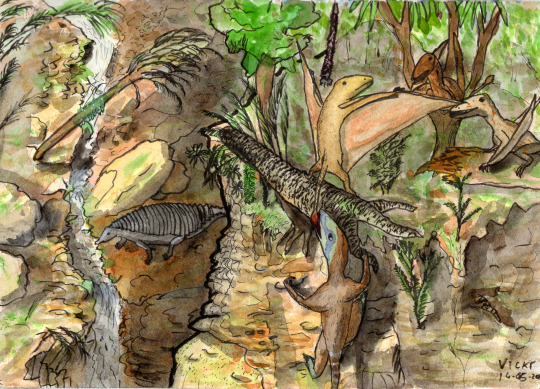
Procompsognathus's cliff climb. Although the foreground cliff itself and the contrast between foreground and background didn't come out quite as well as I'd hoped, I still really like this art featuring the three main branches of archosaur (dinosaur, pterosaur, and pseudosuchian).
June

Anomalocaris, Dragon of the Cambrian. The realisation that most Cambrian creatures were tiny gave me the idea of a whole bunch of them hiding from a 40 cm long Anomalocaris while in positions reminiscent of a D&D party facing off against a dragon.
July
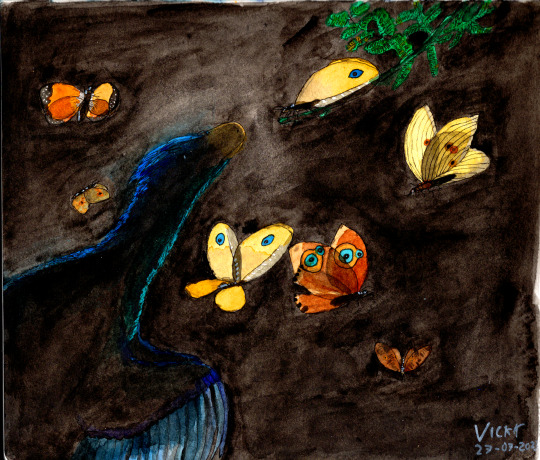
Caihong and the Kalligrammatids. Kalligrammatids were neuropterans that superficially resembled large butterflies, but unlike them their wings were transparent! I combined them with the gorgeous iridescence of Caihong and backlighting for a fun experiment.
August

Spring on the mammoth steppe. When the time came to do some art set in the Quaternary, I decided to depict a real life location and how it would have changed in the past few hundred thousand years. This spot is just west of Baden-Baden (which is in the glacier valley to the upper left), on the edge of the Schwartzwald. I also enjoyed depicting an ice age spring. It wasn't always snow and ice.
September
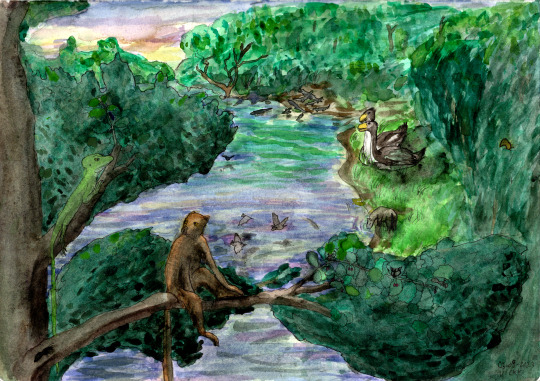
Darwinius and Geiseltaliellus's stare-off. The Paleogene was the last remaining Phanerozoic period I hadn't done any art of, so I drew this little scene in the Messel Pit formation.
October

Inostrancevia family at sunrise. I hadn't drawn Permian synapsids in a while at this point so they were overdue for a paleoart. I also felt like going absolute ham with my reds. The sunrise and Permian volcanism made for a convenient excuse but really, this is just for me.
November
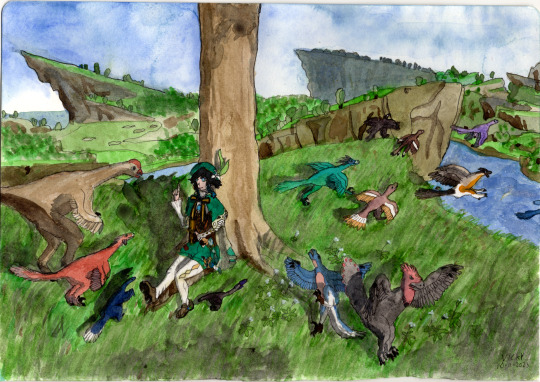
Wind, Courage, and Wings. This one's a birthday gift for my friend, depicting a lovely fable in Genshin Impact about how the wind god Barbatos taught the first birds to fly.
December

The Zanclean Flood. 6 million years ago, the movement of the continents cut the Mediterranean off from the oceans. Since more water evaporates from the Mediterranean than it receives from rivers, this resulted in the sea drying up and becoming an incredibly deep, dry, salty lowland. Until 5.3 million years ago, when the Strait of Gibraltar formed and the entire sea was refilled in a massive flood. This depicts the early days of said flood seen from the tip of the Rock of Gibraltar.
If you've enjoyed my art this year, consider leaving me a tip! Or have a look at last year's art too.
#paleoart#my art#palaeoblr#2023#my art in 2023#watercolour#definitely not gonna tag every creature appearing in these#cw: bugs
52 notes
·
View notes
Text
Where were you on or about the date of the Zanclean Flood?
wanted to complain about the rain but then remembered the last time i did someone blamed my tumblr blog for the desertification of the mediterranean area
5K notes
·
View notes
Quote
Seaflooding is a revolutionary idea that involves flooding arid and saline regions to create new bodies of water, similar to what happened to the Mediterranean Sea thousands of years ago. The Zanclean Megaflood, which occurred around 5.3 million years ago, turned the Mediterranean from a dry, salty wasteland into a thriving body of water that supports life, trade, and the economy. The concept of seaflooding is simple. There are many areas on Earth that are similar to the ancient Mediterranean when it was dry. These areas have low sea levels, high pressure, extreme heat, and are full of concentrated salts brought by rivers that eventually dry up. By bringing water from the sea and flooding these areas, we can create new bodies of water that could provide numerous benefits.
Seaflooding: The Revolutionary Solution to Climate Change and Economic Growth – NETERRA
0 notes
Text
i think it would be nice if my brain didn't decide to randomly remind me of the zanclean flood on a regular basis...
1 note
·
View note
Photo



Geological evidence shows that millions of years ago, the Mediterranean Sea nearly dried out. (Video and image credits: PBS Eons)
#fluid dynamics#science#physics#geology#conservation of mass#continuity equation#Mediterranean#prehistory#zanclean flood
487 notes
·
View notes
Text
The straits of Gibraltar totally closed up 5.96m years ago to create the Messinian salinity crisis, where the Mediterranean Sea dried up [apart from a few highly sailne bodies of water like the Dead Sea].
Then, 5.33m years ago, the straits reopened causing the Zanclean Flood, which refilled the Mediterranean.
Geologists think the straits are likely to close again in the future.

The Strait of Gibraltar is a narrow channel that connects the Atlantic Ocean to the Mediterranean Sea and separates the Iberian Peninsula in Europe from Morocco in Africa. It is 36 miles (58 km) long and just 8 miles (13 km) across at its most narrow point. Around 300 ships cross the Strait of Gibraltar each day — about one ship every five minutes.
35.966667°, -5.483333°
Source imagery: Planet
329 notes
·
View notes